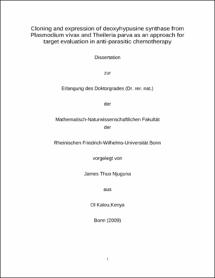Cloning and expression of deoxyhypusine synthase from Plasmodium vivax and Theileria parva as an approach for target evaluation in anti-parasitic chemotherapy

Cloning and expression of deoxyhypusine synthase from Plasmodium vivax and Theileria parva as an approach for target evaluation in anti-parasitic chemotherapy

| dc.contributor.advisor | Kaiser, Annette E. | |
| dc.contributor.author | Njuguna, James Thuo | |
| dc.date.accessioned | 2020-04-14T03:06:14Z | |
| dc.date.available | 2020-04-14T03:06:14Z | |
| dc.date.issued | 08.09.2009 | |
| dc.identifier.uri | https://hdl.handle.net/20.500.11811/4135 | |
| dc.description.abstract | An important issue facing global health today is the need for new, effective and affordable drugs against malaria and a veterinary parasitic disease named Theileriosis, particularly in resource-poor countries. The parasite P. vivax which causes benign malaria and T. parva causing East Coast Fever (ECF) or Theileria annulata causing Tropical Theileriosis (MCF) belong to the group of Apicomplexa which have an apicoplast. The apicoplast is a relic of the chloroplast which is necessary for the parasite to invade its host. Genes of the apicoplast have shown to be very important drug targets since they do not exist in their human or animal counterpart. However nuclear encoded genes which show significant differences with respect to the structural domains of their proteins might also be attractive drug targets. Here we report about the cloning and characterization of the deoxyhypusine synthase gene (DHS) from both parasites. DHS catalyzes the first committed step in the biosynthesis of the unique amino acid hypusine in eukaryotic initiation factor 5A (eIF-5A). The enzyme transfers an aminobutyl moiety from the triamine spermidine to a specific lysine residue of the precursor protein. Deoxyhypusinylated eIF-5A is subsequently hydroxylated by deoxyhypusine hydoxylase (DOHH) which completes eIF-5A activation. Surprisingly we identified 4-saturated piperidone monoesters as putative DOHH inhibitors with antiplasmodial activity. Recent results have shown that DHS is a valuable drug target in P. falciparum for the therapy of cerebral malaria. The putative DHS protein from P. vivax displays a FASTA score of 74 relative to that from the human parasite P. falciparum. The ORF encoding 456 amino acids was expressed under control of IPTG-inducible T7 promoter, and expressed as a protein of approximately 50 kDa (theoretically 52.7 kDa) in E. coli BL21 DE3 cells. The N-terminal histidine-tagged protein was purified by Nickel-chelate affinity chromatography under denaturing conditions. DHS has a theoretical pI of 6.0 and its specific enzymatic activity was determined as 1268 U/mg protein The inhibitor, N-guanyl-1, 7-diaminoheptane (GC7), suppressed specific activity by 36-fold. The Theileria parva gene encodes for an ORF of 371 amino acids with a theoretical pI of 5.4 and a calculated molecular weight of 44,8 kDa. Theileria parva dhs has a FASTA score of 49 to its host Bos taurus. Expression of the histidine tagged protein in pET28a in E. coli BL21 DE3 cells failed. | |
| dc.language.iso | eng | |
| dc.rights | In Copyright | |
| dc.rights.uri | http://rightsstatements.org/vocab/InC/1.0/ | |
| dc.subject.ddc | 540 Chemie | |
| dc.subject.ddc | 610 Medizin, Gesundheit | |
| dc.title | Cloning and expression of deoxyhypusine synthase from Plasmodium vivax and Theileria parva as an approach for target evaluation in anti-parasitic chemotherapy | |
| dc.type | Dissertation oder Habilitation | |
| dc.publisher.name | Universitäts- und Landesbibliothek Bonn | |
| dc.publisher.location | Bonn | |
| dc.rights.accessRights | openAccess | |
| dc.identifier.urn | https://nbn-resolving.org/urn:nbn:de:hbz:5N-18754 | |
| ulbbn.pubtype | Erstveröffentlichung | |
| ulbbnediss.affiliation.name | Rheinische Friedrich-Wilhelms-Universität Bonn | |
| ulbbnediss.affiliation.location | Bonn | |
| ulbbnediss.thesis.level | Dissertation | |
| ulbbnediss.dissID | 1875 | |
| ulbbnediss.date.accepted | 31.09.2009 | |
| ulbbnediss.fakultaet | Mathematisch-Naturwissenschaftliche Fakultät | |
| dc.contributor.coReferee | Müller, Christa E. |
Files in this item
This item appears in the following Collection(s)
-
E-Dissertationen (4116)




